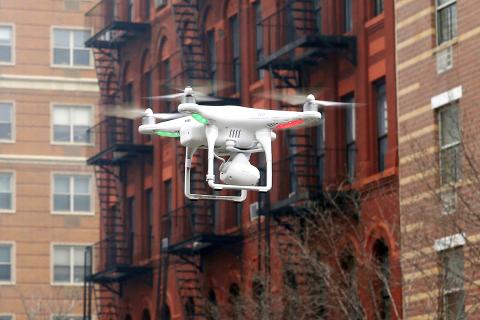An amateur photographer in Portsmouth, New Hampshire, drew crowds when he used a drone mini-helicopter made by China’s DJI Technology Co. to capture images of historic church steeples and other sights.
“I get some amazing photos with it,” said Scott Richardson, a voice teacher who bought DJI’s four-rotor Phantom 2 Vision+ model in May last year. “With a drone, you can hover three feet above the steeple and get a picture you can’t get any other way.” Founded in 2009 by an engineer with a childhood love of radio-controlled model planes, DJI has become the world’s biggest supplier of civilian drones — possibly the first Chinese company to achieve that status in any consumer industry.
It has grown from 20 employees to a workforce of 2,800, including Chinese, Americans and Koreans at its headquarters in this southern Chinese city and at outposts in Los Angeles, Tokyo and Frankfurt.

Photo: Reuters
“It’s really amazing what they have managed to do,” said industry analyst Maryanna Saenko of Lux Research Inc. in Boston.
From the start, DJI was “very polished, had just the right capabilities and the right price point” — less than US$1,000 when most rivals cost at least US$5,000, Saenko said. “They hit the sweet spot.” DJI’s latest model, the Inspire 1, released in November last year, carries a camera that can send live video to a smartphone, with a GPS system to compensate for wind and hold it still in midair.
The company is part of an emerging wave of Chinese startups in fields such as robotics, clean energy and telecommunications. The Communist Party hopes they transform the country from the world’s low-wage factory into a creator of profitable technology.
DJI and its rivals, including France’s Parrot SA and 3D Robotics Inc. of the United States, foresee demand for drones to shoot movies and news footage, survey farmland or oilfields, inspect power lines and oil pipelines and give firefighters a bird’s-eye view of burning buildings.
Privately owned DJI, based in Shenzhen, on the outskirts of Hong Kong, declined to disclose sales or profit figures. But founder Frank Wang told the South China Morning Post in Hong Kong that revenue in 2013 was US$131 million. The company says revenue grows by 300 to 500 percent a year.
For professional use, DJI launched its Spreading Wings series of bigger copters with up to eight rotors last year. They offer advanced steering and image-stabilizing systems and sell for up to US$10,000.
Richardson, a former news photographer, said he got on DJI’s waiting list for the latest Phantom model as soon as he read about it.
“I use it mostly to take pictures from vantage points that you couldn’t get any other way,” he said. Portsmouth’s North Church has been around since the 1600s, but he gets photos of it that “have never been taken, ever.” In February 2012, DJI released its first full-fledged drone, the spindly Flame Wheel. Later that year, it added a camera to the first Phantom after seeing customers mount GoPro Inc.’s wearable video cameras on their drones.
Since then, research has spread to include cameras, software for imaging and control and stabilization systems. Expanding beyond drones, the company has used its know-how in stabilizing images to create the Ronin, a hand-held camera mount. Priced at US$3,000, it is marketed as a lower-cost alternative to steady cam systems used by film and TV studios.
The company has opened its software-development process to outsiders to create additional tools. A Swiss software maker, Pix4D, has designed an application to transform images shot by DJI or other drones into three-dimensional maps. Huawei says its next smartphone model will have an app to control a DJI drone and receive live video.
In October last year, the company briefly entered American pop culture when characters on the “South Park” cartoon used a video-equipped drone modeled on DJI’s Phantom to spy paparazzi-style on their neighbors.
DJI rolls out new models as little as five months apart, a rapid pace that reflects intense competition with smaller brands promising lower prices and more features.
“The development cycle is tricky,” company spokesman Michael Perry said. Referring to the Inspire 1, he said, “One of the main reasons we wanted to get this out is, we didn’t want anyone else to do it first.” Unusually for a startup, DJI handles almost every step of its process itself, from research and production through worldwide sales and repairs. That has led to complaints as repair centers struggle to keep pace with sales.
Richardson had to wait two and a half months for his radio control unit to be returned after a broken switch was replaced.
“I’m very happy with the product,” he said, “but costumer service wasn’t so great.”

April 28 to May 4 During the Japanese colonial era, a city’s “first” high school typically served Japanese students, while Taiwanese attended the “second” high school. Only in Taichung was this reversed. That’s because when Taichung First High School opened its doors on May 1, 1915 to serve Taiwanese students who were previously barred from secondary education, it was the only high school in town. Former principal Hideo Azukisawa threatened to quit when the government in 1922 attempted to transfer the “first” designation to a new local high school for Japanese students, leading to this unusual situation. Prior to the Taichung First

When the South Vietnamese capital of Saigon fell to the North Vietnamese forces 50 years ago this week, it prompted a mass exodus of some 2 million people — hundreds of thousands fleeing perilously on small boats across open water to escape the communist regime. Many ultimately settled in Southern California’s Orange County in an area now known as “Little Saigon,” not far from Marine Corps Base Camp Pendleton, where the first refugees were airlifted upon reaching the US. The diaspora now also has significant populations in Virginia, Texas and Washington state, as well as in countries including France and Australia.

On April 17, Chinese Nationalist Party (KMT) Chairman Eric Chu (朱立倫) launched a bold campaign to revive and revitalize the KMT base by calling for an impromptu rally at the Taipei prosecutor’s offices to protest recent arrests of KMT recall campaigners over allegations of forgery and fraud involving signatures of dead voters. The protest had no time to apply for permits and was illegal, but that played into the sense of opposition grievance at alleged weaponization of the judiciary by the Democratic Progressive Party (DPP) to “annihilate” the opposition parties. Blamed for faltering recall campaigns and faced with a KMT chair

Article 2 of the Additional Articles of the Constitution of the Republic of China (中華民國憲法增修條文) stipulates that upon a vote of no confidence in the premier, the president can dissolve the legislature within 10 days. If the legislature is dissolved, a new legislative election must be held within 60 days, and the legislators’ terms will then be reckoned from that election. Two weeks ago Taipei Mayor Chiang Wan-an (蔣萬安) of the Chinese Nationalist Party (KMT) proposed that the legislature hold a vote of no confidence in the premier and dare the president to dissolve the legislature. The legislature is currently controlled